Page 280 of 488
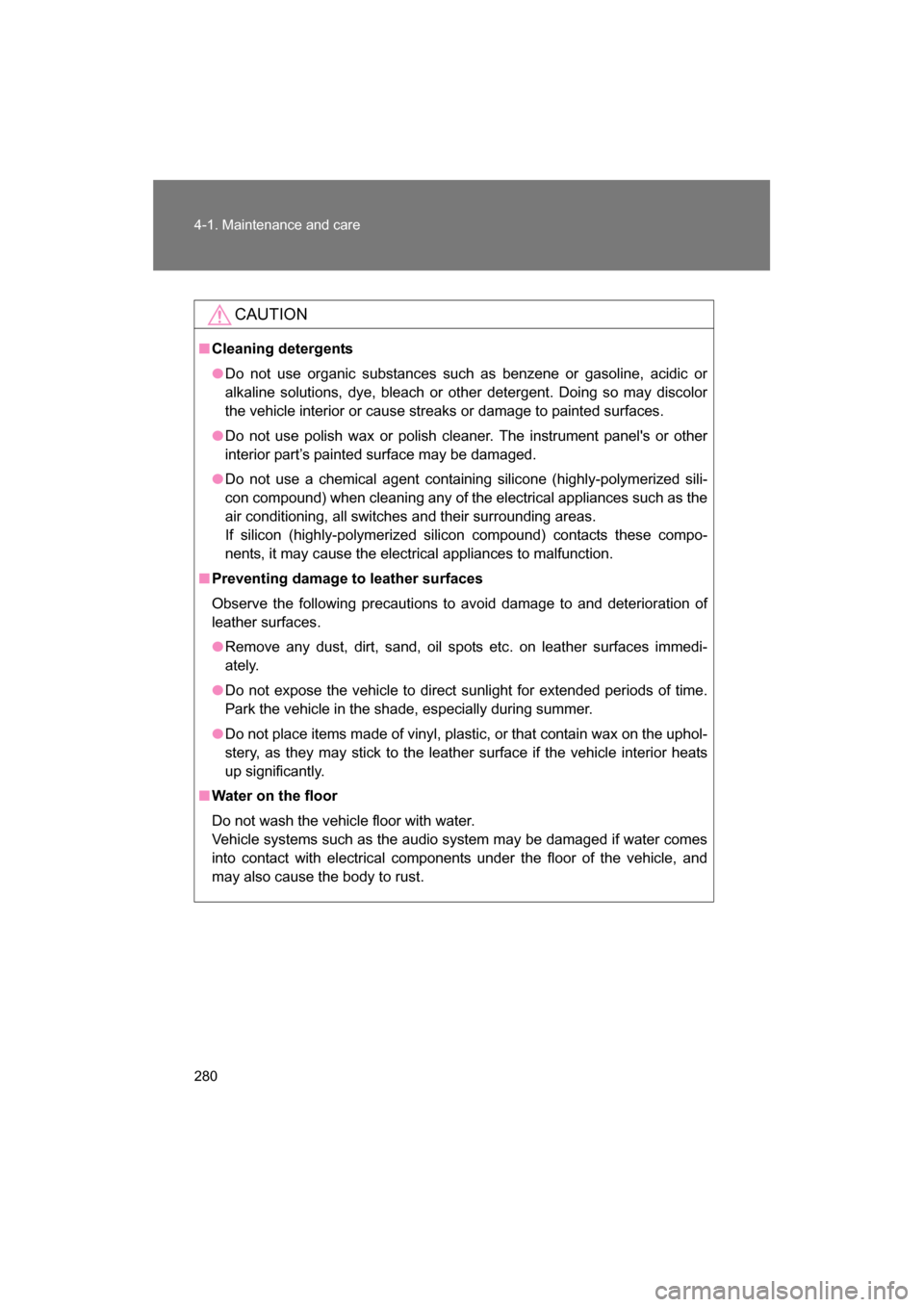
280
4-1. Maintenance and care
CAUTION
■Cleaning detergents
●Do not use organic substances such as benzene or gasoline, acidic or
alkaline solutions, dye, bleach or other detergent. Doing so may discolor
the vehicle interior or cause streaks or damage to painted surfaces.
●Do not use polish wax or polish cleaner. The instrument panel's or other
interior part’s painted surface may be damaged.
●Do not use a chemical agent containing silicone (highly-polymerized sili-
con compound) when cleaning any of the electrical appliances such as the
air conditioning, all switches and their surrounding areas.
If silicon (highly-polymerized silicon compound) contacts these compo-
nents, it may cause the electrical appliances to malfunction.
■Preventing damage to leather surfaces
Observe the following precautions to avoid damage to and deterioration of
leather surfaces.
●Remove any dust, dirt, sand, oil spots etc. on leather surfaces immedi-
ately.
●Do not expose the vehicle to direct sunlight for extended periods of time.
Park the vehicle in the shade, especially during summer.
●Do not place items made of vinyl, plastic, or that contain wax on the uphol-
stery, as they may stick to the leather surface if the vehicle interior heats
up significantly.
■Water on the floor
Do not wash the vehicle floor with water.
Vehicle systems such as the audio system may be damaged if water comes
into contact with electrical components under the floor of the vehicle, and
may also cause the body to rust.
Page 282 of 488
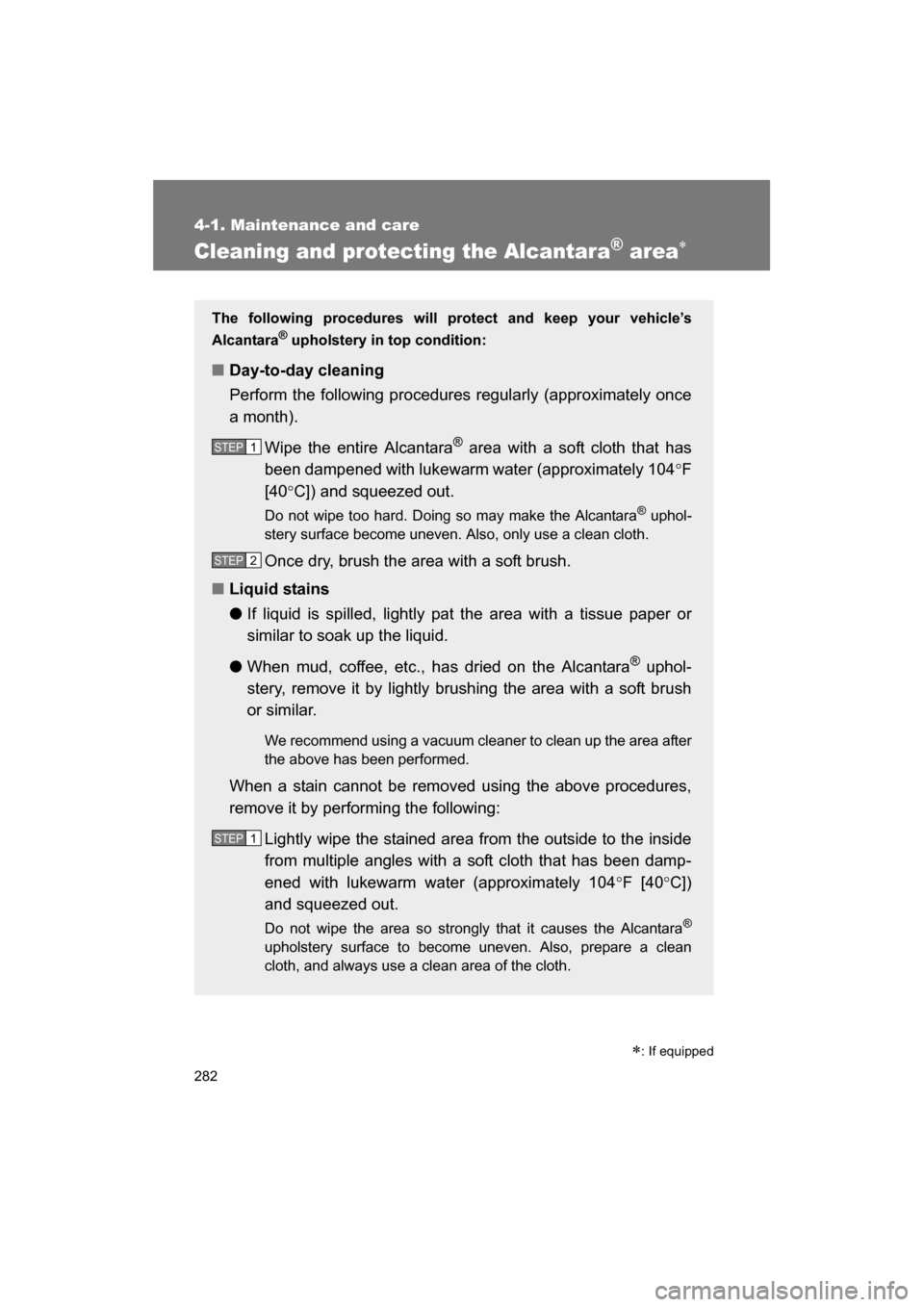
282
4-1. Maintenance and care
Cleaning and protecting the Alcantara® area∗
∗: If equipped
The following procedures will protect and keep your vehicle’s
Alcantara
®
upholstery in top condition:
■Day-to-day cleaning
Perform the following procedures regularly (approximately once
a month).
Wipe the entire Alcantara ®
area with a soft cloth that has
been dampened with lukewarm water (approximately 104 °F
[40 °C]) and squeezed out.
Do not wipe too hard. Doing so may make the Alcantara ®
uphol-
stery surface become uneven. Also, only use a clean cloth.
Once dry, brush the area with a soft brush.
■Liquid stains ● If liquid is spilled, lightly pat the area with a tissue paper or
similar to soak up the liquid.
● When mud, coffee, etc., has dried on the Alcantara ®
uphol-
stery, remove it by lightly brushing the area with a soft brush
or similar.
We recommend using a vacuum cleaner to clean up the area after
the above has been performed.
When a stain cannot be removed using the above procedures,
remove it by performing the following:
Lightly wipe the stained area from the outside to the inside
from multiple angles with a soft cloth that has been damp-
ened with lukewarm water (approximately 104 °F [40 °C])
and squeezed out.
Do not wipe the area so strongly that it causes the Alcantara ®
upholstery surface to become uneven. Also, prepare a clean
cloth, and always use a clean area of the cloth.
STEP 1
STEP 2
STEP 1
Page 283 of 488
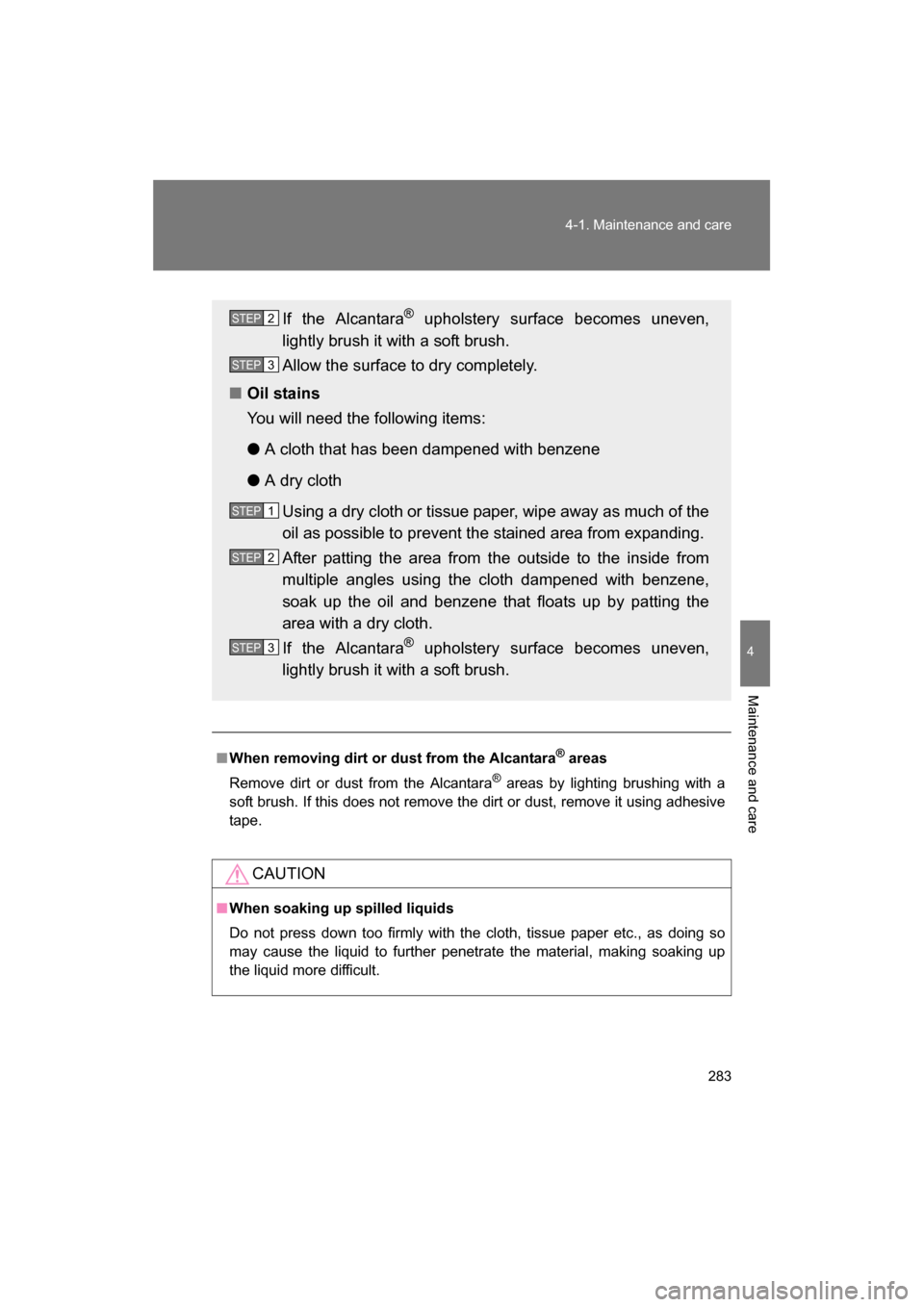
283
4-1. Maintenance and care
4
Maintenance and care
■When removing dirt or dust from the Alcantara®
areas
Remove dirt or dust from the Alcantara ®
areas by lighting brushing with a
soft brush. If this does not remove the dirt or dust, remove it using adhesive
tape.
CAUTION
■When soaking up spilled liquids
Do not press down too firmly with the cloth, tissue paper etc., as doing so
may cause the liquid to further penetrate the material, making soaking up
the liquid more difficult.
If the Alcantara ®
upholstery surface becomes uneven,
lightly brush it with a soft brush.
Allow the surface to dry completely.
■Oil stains
You will need the following items: ● A cloth that has been dampened with benzene
● A dry cloth
Using a dry cloth or tissue paper, wipe away as much of the
oil as possible to prevent the stained area from expanding.
After patting the area from the outside to the inside from
multiple angles using the cloth dampened with benzene,
soak up the oil and benzene that floats up by patting the
area with a dry cloth.
If the Alcantara ®
upholstery surface becomes uneven,
lightly brush it with a soft brush.
STEP 2
STEP 3
STEP 1
STEP 2
STEP 3
Page 286 of 488
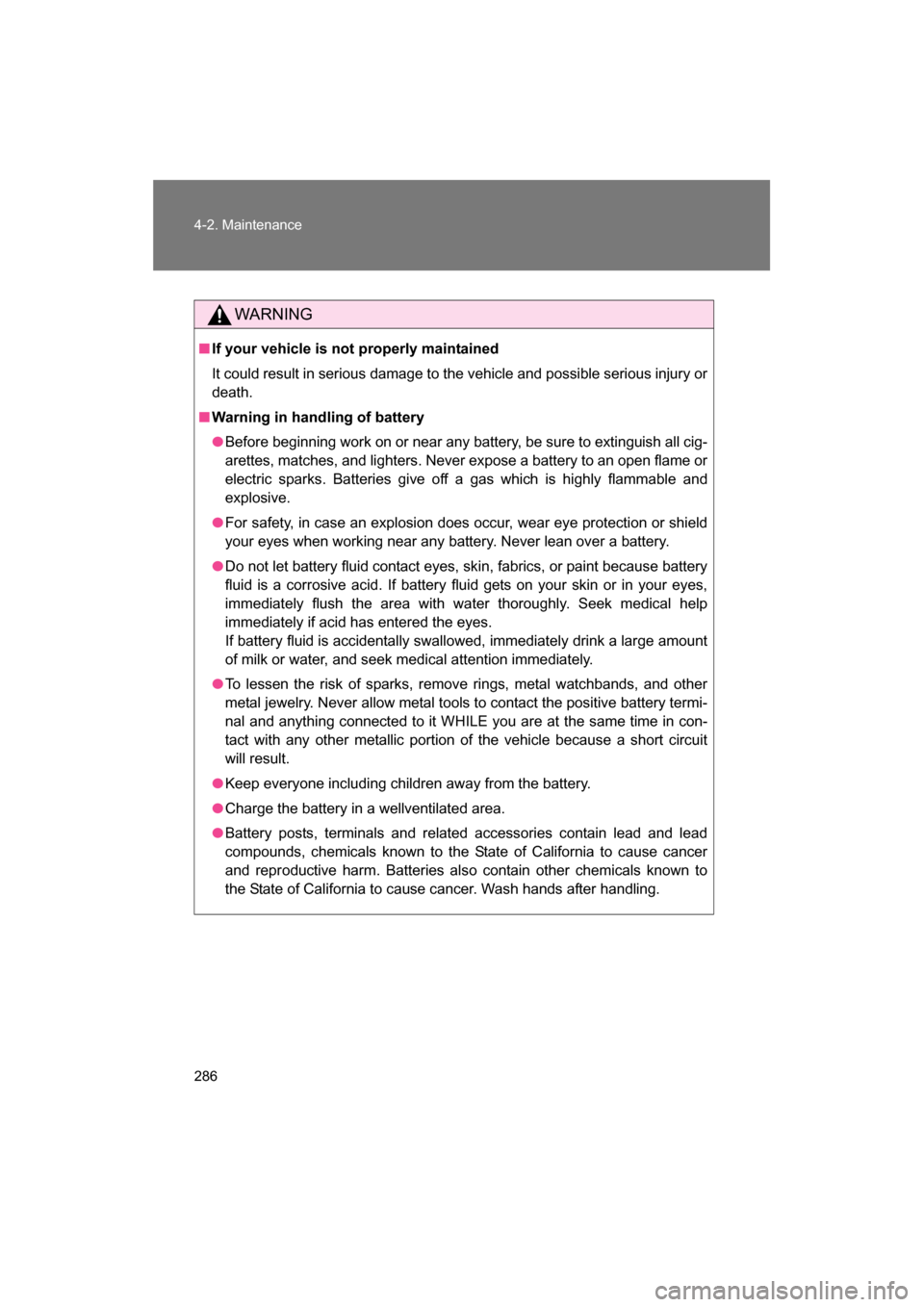
286
4-2. Maintenance
WARNING
■If your vehicle is not properly maintained
It could result in serious damage to the vehicle and possible serious injury or death.
■Warning in handling of battery
●Before beginning work on or near any battery, be sure to extinguish all cig-
arettes, matches, and lighters. Never expose a battery to an open flame or
electric sparks. Batteries give off a gas which is highly flammable and
explosive.
●For safety, in case an explosion does occur, wear eye protection or shield
your eyes when working near any battery. Never lean over a battery.
●Do not let battery fluid contact eyes, skin, fabrics, or paint because battery
fluid is a corrosive acid. If battery fluid gets on your skin or in your eyes,
immediately flush the area with water thoroughly. Seek medical help
immediately if acid has entered the eyes.
If battery fluid is accidentally swallowed, immediately drink a large amount
of milk or water, and seek medical attention immediately.
●To lessen the risk of sparks, remove rings, metal watchbands, and other
metal jewelry. Never allow metal tools to contact the positive battery termi-
nal and anything connected to it WHILE you are at the same time in con-
tact with any other metallic portion of the vehicle because a short circuit
will result.
●Keep everyone including children away from the battery.
●Charge the battery in a wellventilated area.
●Battery posts, terminals and related accessories contain lead and lead
compounds, chemicals known to the State of California to cause cancer
and reproductive harm. Batteries also contain other chemicals known to
the State of California to cause cancer. Wash hands after handling.
Page 292 of 488
292
4-3. Do-it-yourself maintenance
ItemsParts and tools
Light bulbs ( →P. 340)
Page 294 of 488
294
4-3. Do-it-yourself maintenance
Engine hood
Release the lock from the inside of the vehicle to open the engine
hood.Pull the engine hood release
lever.The engine hood will pop up
slightly.
Push the auxiliary catch lever
to the left and lift the engine
hood.
Hold the engine hood open by
inserting the supporting rod
into the slot.
STEP 1
STEP 2
STEP 3
Page 303 of 488
303
4-3. Do-it-yourself maintenance
4
Maintenance and care
■Adding fluid
Make sure to check the fluid type and prepare the necessary items.
Fluid typeFMVSS No.116 fresh DOT 3 or DOT 4 brake fluid
ItemsClean funnel
■Brake fluid can absorb moisture from the air
Excess moisture in the fluid can cause a dangerous loss of braking effi-
ciency. Use only newly opened brake fluid.
WARNING
■When filling the reservoir
Take care because brake fluid can harm your hands or eyes and damage
painted surfaces.
If fluid gets in your eyes, flush your eyes with clean water immediately.
If you still experience discomfort, see a doctor.
CAUTION
■If the fluid level is low or high
It is normal for the brake fluid level to go down slightly as the brake pads
wear or when the fluid level in the accumulator is high.
If the reservoir needs frequent refilling, it may indicate a serious problem.
Page 307 of 488
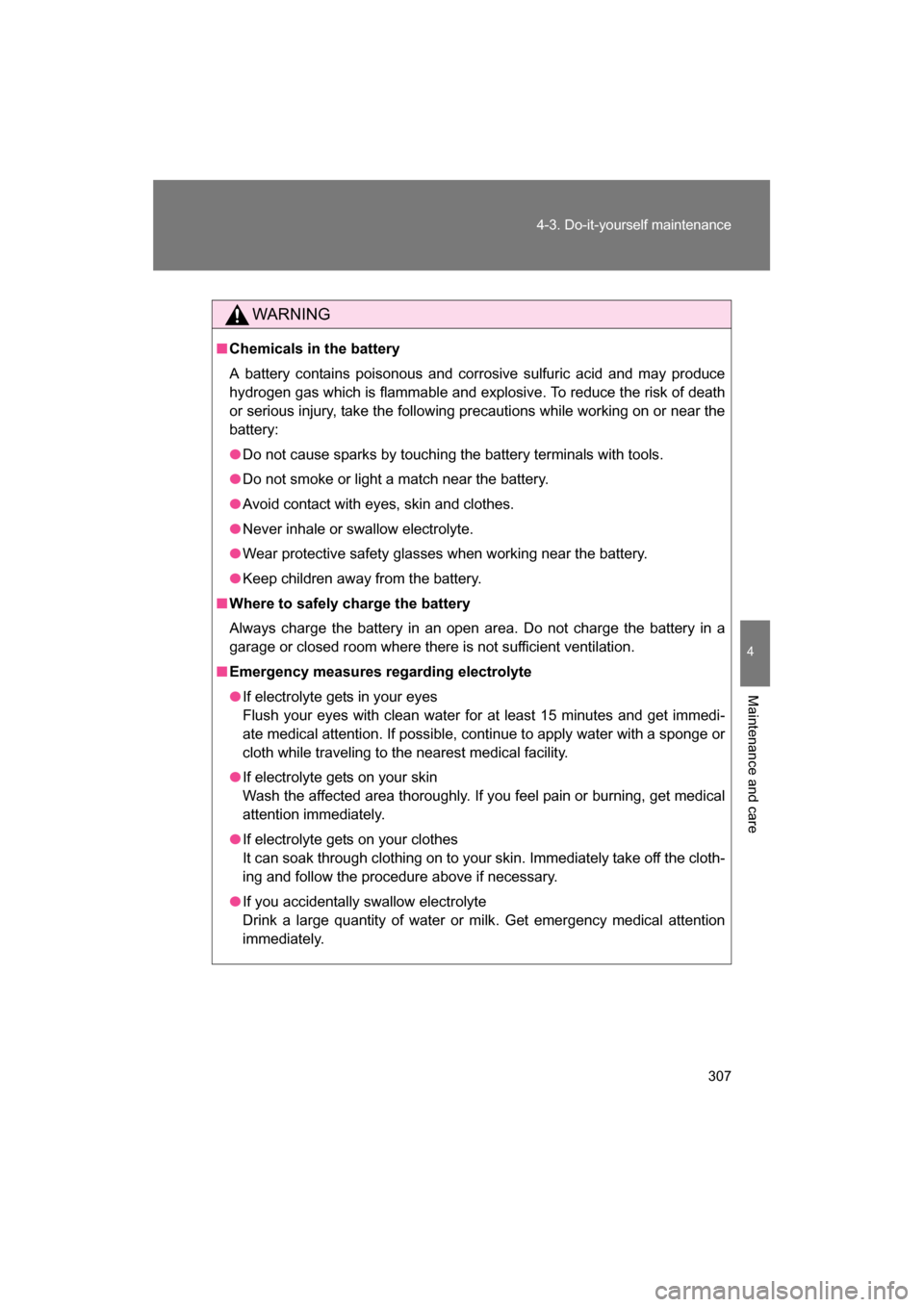
307
4-3. Do-it-yourself maintenance
4
Maintenance and care
WARNING
■Chemicals in the battery
A battery contains poisonous and corrosive sulfuric acid and may produce
hydrogen gas which is flammable and explosive. To reduce the risk of death
or serious injury, take the following precautions while working on or near the
battery:
●Do not cause sparks by touching the battery terminals with tools.
●Do not smoke or light a match near the battery.
●Avoid contact with eyes, skin and clothes.
●Never inhale or swallow electrolyte.
●Wear protective safety glasses when working near the battery.
●Keep children away from the battery.
■Where to safely charge the battery
Always charge the battery in an open area. Do not charge the battery in a
garage or closed room where there is not sufficient ventilation.
■Emergency measures regarding electrolyte
●If electrolyte gets in your eyes
Flush your eyes with clean water for at least 15 minutes and get immedi-
ate medical attention. If possible, continue to apply water with a sponge or
cloth while traveling to the nearest medical facility.
●If electrolyte gets on your skin
Wash the affected area thoroughly. If you feel pain or burning, get medical
attention immediately.
●If electrolyte gets on your clothes
It can soak through clothing on to your skin. Immediately take off the cloth-
ing and follow the procedure above if necessary.
●If you accidentally swallow electrolyte
Drink a large quantity of water or milk. Get emergency medical attention
immediately.